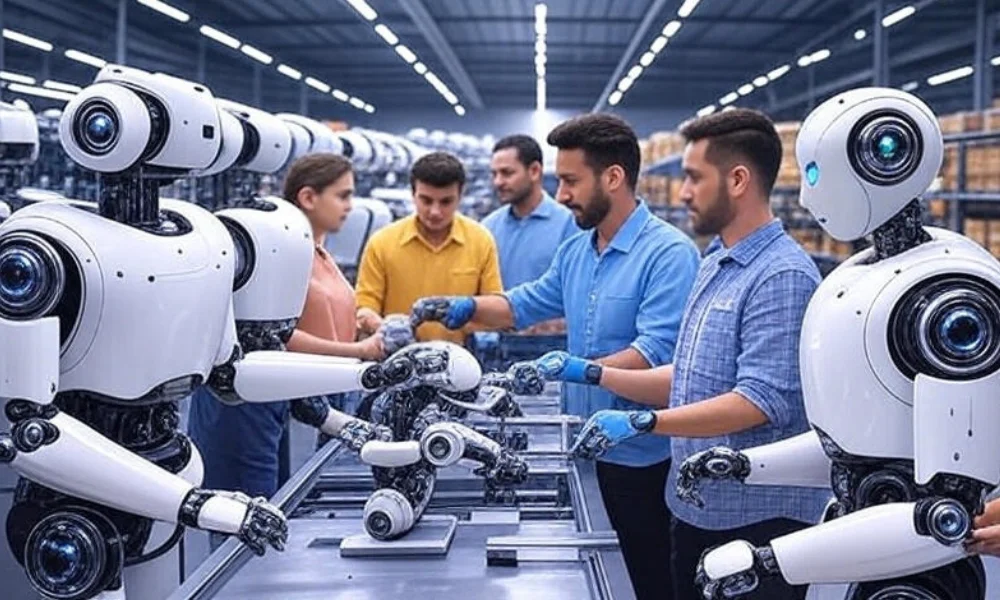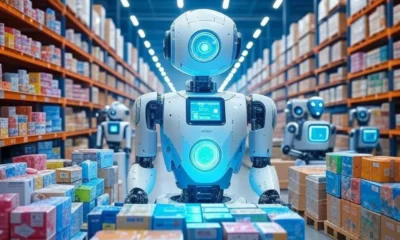Artificial Intelligence
AI-Powered Robotics and AMRs:
AI-powered robotics and autonomous mobile robots are changing how warehouses operate by increasing speed and reducing errors. Explore how these smart systems improve inventory management and order fulfillment in modern warehouses.

I realize that warehouses are changing rapidly these days and the demand for smart solutions keeps increasing. To compete in the market, many companies, like mine, focus on quicker order handling and proper management of stock. There is a way out and that is with AI-driven robotics and autonomous mobile robots (AMRs). Thanks to these technologies, we can move and store goods in new ways every day.
Definition:
ARMs and AMPRs are automated and smart machine learning solutions that can do warehouse work using artificial intelligence instead of needing continuous input from people.
For me, this topic is useful because automation in warehouses saves costs, ensures accurate work and improves the speed of all warehouse activities. I am here today to let you know how smart warehouse systems, their advantages and why businesses should consider them. I have some helpful information if AI interests you or you’re wondering how to improve your warehouse.
What Are Autonomous Robots and Mobile Robots?
- Many ask me to compare AI-powered robotics and AMRs with regular machines used in warehouses. These, in my experience, are much smarter systems than mere machines, as they learn and develop on their own. With artificial intelligence, these robots are able to sense, think and decide what to do during their tasks. They act based on what is happening around them in the moment, not only following a distant set of directions.
- Autonomous Mobile Robots or AMRs, are robotic systems that don’t use tracks or wires and can move around independently. AMRs stand out since they can plan how to reach a destination, avoid obstacles and adjust their route when an obstacle is in the way. Using LIDAR, cameras and sensors on their vehicles, they manage to move safely among other machines in the warehouse.
- I’ve observed that AI-driven robots and AMRs streamline and speed up work in the warehouse. They help increase efficiency, cut down on mistakes and make the work feel smoother. That is why I think they will become the main type of warehouse automation here in the United States.
Key Functions of AI-Autonomous Robots and AMRs in Warehouses:
It’s been interesting to see that AI robots and AMRs now handle tasks that used to be very time-consuming which has improved how the warehouse is managed. Such systems are capable of handling things more quickly, accurately and smartly than human work. Therefore, I ask them to supervise picking, sorting, moving goods and keeping the inventory in check.
Picking and Sorting:
Using smart cameras and sensors, AI robots can rapidly pick and manage a variety of products carefully. They do not randomly take items. Instead, they pick correctly and hardly ever mix up what they need. Because of this, I can handle more orders without thinking much about mistakes that would be costly.
Inventory Management:
I have used AMRs that can scan whatever is on the shelves and instantly report stock changes without disrupting any work. They track everything using RFID tags and vision systems for top accuracy. So I am always aware of what is in stock and can locate it right away.
Transport and Delivery:
Robots move items around the warehouse by avoiding possible obstacles and following optimized paths. I like how paths are recalculated when people are passing by or when something is in the middle of the road. It means that everyday actions are less likely to pose risks.
Palletizing and Depalletizing:
With robotic arms, it is easy to lift, stack and unstack items of different shapes and sizes without harm. They allow my team to move faster and are less risky for them. It allows robots to hold and place things as accurately as people.
Human-Robot Collaboration:
Workers are not replaced by AMRs and AI robots; instead, they help them. I have witness hybrid robots being teamed up with workers to complete physical and repetitive tasks. They make the team more efficient and allow them to attend to more important tasks.
Advantages of Using AI-Driven Robotics and AMRs:
Right after I relied on AI-equipped robotics and AMRs in my warehouse, I observed their benefits right away. These methods made work more effective in the long run, reduced expenses and increased accuracy. I wish to explain the main reasons I think every modern warehouse should try out these new technologies.
Boosted Efficiency and Speed:
AI support is available all the time, so I don’t have to worry about the demand becoming too high at any point. They can pick, sort and deliver goods faster and more safely than humans due to not causing traffic jams on the warehouse floor. AMRs have led to quicker turnaround times for orders by several hours.
Less spending on employees and lower security risks are among the advantages:
By having robots do the repetitive and heavy work, I have reduced overtime pay. It also helps prevent injuries and lessen stress for employees. Robots are used for hard labor, allowing the staff to focus on things that require more skill.
More Scalability and Flexibility:
As my warehouse gets busier, I increase my fleet rather than adding more floor space. These robots are able to update their programming when changes to the setup and responsibilities take place. This approach allows me to expand without needing to invest greatly in my infrastructure.
Improved Accuracy and Fewer Errors:
Because of their accuracy, AI robots cause fewer errors in picking and as a result, customers are happier and have little need for returns. AMRs keep a complete history of items moving, making sure inventory information stays accurate at all times. It is difficult to achieve such exact results using manual methods.
Smarter Decision-Making with Data:
Robots measure and gather working data throughout their tasks and I rely on it to enhance my activities. I can see the flow of traffic, how trucks are packed and the energy required to power the entire fleet. It makes it easier for me to make wiser decisions each day.
What Are Some Examples of AMRs and Robots Used in Real-Life?
It’s always useful to watch how other companies put new technology to work and AI-powered robotics are no exception. I studied examples in industry to learn how major players were able to greatly automation warehouse benefit from using these systems. As a result of their success, I believed that robotics would be a good fit in my warehouse.
Amazon Robotics (formerly Kiva Systems):
Amazon has thousands of robots helping to move products within its fulfillment centers. The use of these AMRs reduces the time workers take to walk and helps them finish picking orders faster. I found out that using this system, Amazon ships tens of millions of items per day almost flawlessly.
Locus Robotics in 3PL Warehouses:
I noticed that third-party logistics companies use Locus robots to help human workers handle fast tasks. They carry bins, move out of the way of obstacles and make the workplace safer for staff. As a result, picking products is done more rapidly and with less wear on team members.
Fetch Robotics by Zebra Technologies:
Fetch robots are commonly used to automate inventory control and the movement of goods within a facility. I have come across case studies where retailers using these systems reduced time spent on travel and made their spaces more efficient. Real-time updates from the sensors allow warehouse activities to run more smoothly and dependably.
Alibaba’s Smart Warehouses in China:
Even being far away from us, the system developed by Alibaba caught my attention. At some places, robots are responsible for handling well over half of what needs to be done. This shows what can be done when people and businesses bring these technologies fully to life.
DHL’s AMR-Driven Logistics Hubs:
In their international hubs, DHL employs AMRs to sort packages as well as move them internally. They have found processing to be quicker and fewer mistakes are being made. I found it noteworthy that they are aiming to build up their robot fleet even more in the following years.
What Problems May I Face While Adopting Robots and AMRs with AI?
I have benefited a lot from using automation, yet I still have to admit that integrating AI-powered robots and AMRs is tricky. As with all new technologies, you should be ready for the challenges it may bring. It took me some time to face a few roadblocks before achieving the rewards.
High Initial Investment Costs:
It was a costly process to set up AI robotics in my warehouse. To purchase the robots, install the software and train my team, I had to come up with a significant budget. But I understood that my savings in the future and reducing energy use over time would make up for what I spent now.
System Integration With Older Technology:
Some of our old software and machinery were outdated and did not work together with the new AI software. I had to improve the network and make everything fit with the updated system. At first, adapting to these new ideas slowed us down, but it was worth all the trouble.
Employee Concerns and Skill Gaps:
Certain members of the team worried that robots might take their jobs away. I made it clear that we aimed to work alongside them and not to take their duties. In addition, we held lessons so that every member of the group could learn new things and team up with the robots.
Technical Issues in Complex Environments:
In a busy warehouse, issues often arise during the day. They may find it difficult to navigate very small aisles, obstacles or things that don’t fit the usual size. I found out that updating software regularly and planning the website’s layout well are important for smooth running.
Maintenance and Support Needs:
These advanced robots should be treated like any other technology in regards to maintenance. When I run into problems or slowdowns, getting an expert to help quickly is critical. I wanted to prevent lengthy delays and downtime so I selected a vendor with good U.S.-based support.
Where Do AI Robotics and AMRs Stand in the Warehouse Next?
Being involved with this technology on a daily basis, I have observed just how quickly it is developing. AI makes robotics and AMRs progress in terms of smartness, speed and flexibility all the time. I think we can expect even greater and more efficient changes in warehouse automation going forward.
Smarter AI Algorithms Are Coming:
New AI models will enable robots to pick up newly learned skills more easily and handle surprises in their environment. In time, I expect robots to think on their feet and change their routes to keep moving, without aid from humans. Having that amount of freedom helps people perform better each day.
Edge AI Will Eliminate the Rely on Cloud-based Services:
I’ve started working with tech that processes tasks close to where the data is generated instead of in the cloud. In other words, the information is processed where the robot is and not on a remote database. Because of that, the processes stay smooth and fast even when the internet is unreliable or runs slowly.
Swarm Robotics Will Transform Coordination:
I find it very interesting when teams of tiny robots collaborate to do a task like a group. Robots usually do not focus on just one task but instead split their work and organize themselves. This approach will allow me to deal with higher volumes of orders more easily.
Working towards sustainability and using green energy will be more important than before:
Many people are already talking about energy-saving robots and eco-friendly logistics. I am looking into energy-saving robots that run on battery in my warehouse. Because of this, businesses spend less money and contribute to the environment which customers care about more each year.
Robotics Expanding Beyond Warehousing:
I’ve noticed that these new technologies are being used in retail restocking, shipments to the final destination and in the medical field. So, it seems clear that AI robotics will soon be seen in our daily lives. If your business carries or sells goods, you should check out these options now.
Conclusion:
Using AI for robotics and AMRs in my warehouse has truly made a difference in how I work from then on. Using software systems, I can handle tasks faster, make fewer mistakes and save on costs, making our jobs safer and more comfortable. What were once just research projects have turned into daily AI tools that I really need.
I recommend that anyone handling a warehouse or considering improvements should take a look at this technology now. Regardless of your level, Intuitive Artificial Intelligence and automated mobile robots can help your business remain competitive. Now, small businesses like mine are making it clear that AI is valuable for everyone.
Thanks to these tools, managing inventory is easier, deliveries are more reliable and growing my business is less stressful. While investing can feel daunting at the start, the rewards you gain in the future are more than worth it. I strongly believe my warehouse would not be properly organized without their help. Would you feel comfortable having robots controlled by AI handle your warehouse management? What do you think about interacting with autonomous mobile robots as part of your regular tasks? Do you recognize or apply the benefits of AI technologies in your business?
-

 Artificial Intelligence8 months ago
Artificial Intelligence8 months agoHow to Use Grok AI: A Complete Guide
-

 Artificial Intelligence10 months ago
Artificial Intelligence10 months agoWhat is Artificial Intelligence? A Comprehensive Guide for Businesses and Enthusiasts
-

 Artificial Intelligence9 months ago
Artificial Intelligence9 months agoUnlocking the Power of Artificial Intelligence Tools
-

 Artificial Intelligence9 months ago
Artificial Intelligence9 months agoWhat is DeepSeek? Revolutionizing AI with Cutting-Edge Solutions
-

 Artificial Intelligence5 months ago
Artificial Intelligence5 months agoAI Technologies in Warehouse Automation:
-

 Artificial Intelligence5 months ago
Artificial Intelligence5 months agoPredictive Analytics for Demand Forecasting:
-

 Artificial Intelligence6 months ago
Artificial Intelligence6 months agoMeta’s AI Push: The Standalone Assistant App Set to Rival ChatGPT
-

 Artificial Intelligence5 months ago
Artificial Intelligence5 months agoHow Artificial Intelligence is Revolutionizing Logistics:



sprunkiy.com
05/22/2025 at 5:36 PM
I’ve always admired how music-based games like Incredibox blend creativity and play. The Sprunki Incredibox mod elevates this even further with fresh beats and visuals-truly a treat for fans!